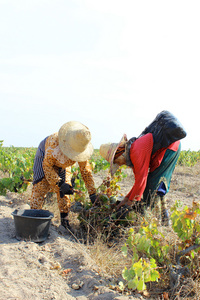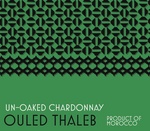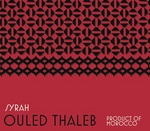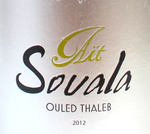Ouled Thaleb >
Zenata >
Morocco|
 |
Domaine Ouled Thaleb is named after the tribe that owns the vineyards' land and works at the winery. It was established in 1923. Located in the Zenata coastal appellations between Casablanca and Rabat, Ouled Thaleb led the renewal of the Moroccan wine industry in the 1990’s. While most of their fruit is estate grown, Ouled Thaleb partners with neighboring growers in order to produce classic style wines under the direction of winemaker Stephane Marriot. The vines are gobelet trained to protect from the heat. Although the temperatures are high during the day, the Atlantic Ocean provides a cooling breeze and it is much cooler than in Meknes (which is further inland), with lower temperature at night.
Farming practices: the grapes are grown organically.
With its high mountains (Atlas) and maritime influence, Morocco is a great area for growing grapes. French settlers brought their wine traditions with them when Morocco was a protectorate of France (1912-1956). When the settlers left after Morocco regained its independence, the kingdom of Morocco took ownership of the vineyards. The industry lost not only the French expertise that had created it, but also an important consumer base, both locally and in mainland France. As a result, the vineyards were either abandoned or replanted with cereal crops, and the production went from 400 million bottles a year to almost nothing - the Zniber family was the only one to keep the tradition alive at the Celliers de Meknes. It took King Hassan II - a graduate of the University of Bordeaux and friend of several producers there - several years to revive the industry. By offering French producers special prices to rent the land, he attracted several companies that replanted the vineyards with Carignan, Cinsaut and Grenache followed by Syrah, Cabernet Sauvignon and Merlot. Since 2000, the industry is slowly regaining some of its splendor, and is back to producing about 43 million bottles. Most of them (more than 50%, and in some cases a lot more) are consumed locally. While the sale of alcohol to Muslims is in theory prohibited, the law is rarely applied. |
 |
| Zenata - Moroccan White blend |
AOG Zenata. 60% Faranah, 40% Clairette, all from sandy shales and sand gravel soil. Fermented in stainless steel tanks. Notes of grapefruit, orange blossom, passion fruit, elderflower and spearmint. A floral and aromatic white with a refreshing finish.
|
 |
| Zenata - Moroccan Red blend |
AOG Zenata. 70% Cabernet Sauvignon, 30% Grenache, all from sandy shales and sand gravel soil. Aged 10 months in French oak. Plum, spices, black cherry and light vanilla notes on the nose. Firm and juicy on the palate.
|
 |
| Zenata - Moroccan Rosé |
AOG Zenata. 60% Syrah, 30% Grenache, 10% Cinsault, all from sandy shales and sand gravel soil. Fermented in stainless steel tanks. Beautiful salmon color with notes of watermelon, white cranberries and rose petals. Bright, crisp, and a touch savory on the palate – perfect with mezze.
|
 |
| Zenata - Un-oaked Chardonnay |
AOG Zenata. 100% Chardonnay, from vines grown in clay soil. Fermented in concrete tanks. Notes of green apple and pear, lots of minerality, clean finish.
|
 |
| Zenata - Medaillon Sauvignon Blanc |
AOG Zenata. 100% Sauvignon Blanc from sandy shales and sand gravel soil. Fermented in stainless steel tanks. Notes of tropical fruits, green bell peppers and jalapeno peppers, lifted by a refreshing acidity.
|
 |
| Zenata - Medaillon red |
AOG Zenata. 60% Cabernet Sauvignon, 30% Merlot, 10% Syrah, all from sandy shales and sand gravel soil. Aged 12 months in French oak, 1/3 new. Notes of black cherry, cassis and plum, subtle spices, juicy with soft tannins on the palate.
|
 |
| Zenata - Syrah |
AOG Zenata. 100% Syrah from vines grown on clay soil. Fermented in concrete tanks. Aged in French oak for 12 months, 1/3 new. Wild berry fruit, bacon and spices, blackberry and smoky on the palate with a fresh and lively finish.
|
 |
| Zenata - Aït Souala |
AOG Zenata. 50% Arinarnoa, 25% Tannat, 25% Malbec. Arinarnoa is a variety that was obtained by the INRA (Institut National de la Recherche Agronomique) in 1956. Based on genetic analyses carried out in Montpellier, it comes from the crossbreeding of Merlot and Cabernet-Sauvignon. The round-shaped berries berries have an herbaceous flavor.
This blend is named after the famous 1931 Ait Souala estate, once the largest winemaking facility of Africa (in 1960 producing the equivalent of 60 million bottles). Harvested and produced on the Ben Slimane plateaux. The vineyards average 25 year old, and the vines grow on sand and sandy shales, at 200 ft high. Fermented and aged separately for 24 months in 1/3 blend of new/used Burgundian French oak, and 2/3 concrete tanks. Final blend in concrete.
Dark ruby color with purple reflection. Very expressive on the nose, with black and red fruit such as blackcurrant, blackberry, raspberry and cherry. Spices and tobacco notes, with a touch of herbaceousness on the nose. Well balanced, bright and rich on the palate with silky tannins.
|
 |
| Zenata - Signature |
AOG Zenata. 50% Marselan, 35% Petit Verdot, 15% Carmenere. Marselan is a French red grape that is a cross between Cabernet Sauvignon and Grenache. It is heat resilient and well-suited to Morocco’s climate. This special cuvée, created by winemaker Stéphane Mariot, originates from 25 year old vines at 300ft altitude, on the Atlantic coast. The vines grow on sand and sandy shales.
The grapes are hand-harvested, destemmed, and go through a 48hr cold maceration. They are fermented in concrete tanks, at temperatures no higher than 28C (82F) to preserve the freshness of the aromas. The wine is then aged for 18 months in 15% new and 85% used Burgundian oak barrels. Final blending of all three varieties in used oak, followed by 10 months in the bottle before release.
Intense aromas of dark fruit and chocolate mixed with floral notes. The same notes translate to the palate. Velvety tannins and a juicy, lingering finish.
|

